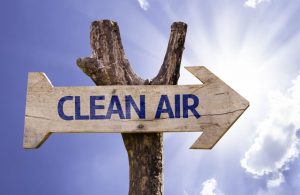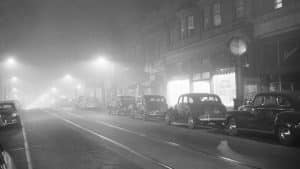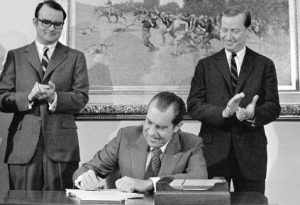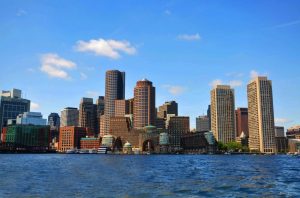Clean Air Day 2015: 52 Years of Clean Air
 We celebrate Clean Air Day on December 17 each year in honor of the Clean Air Act, which was first passed on that day in 1963. The Clean Air Act, which is a federal law, was originally adopted in an effort to control air pollution. It was one of the first environmental laws in the United States and it helped pave the way for future environmental safeguards, including the Clean Water Act of 1972, which protects our nation’s waters. Both the Clean Air Act and the Clean Water Act are administered by the U.S. Environmental Protection Agency (EPA) in coordination with state and local governments. To this day, the Clean Air Act remains one of the most exhaustive air quality laws in the world.
We celebrate Clean Air Day on December 17 each year in honor of the Clean Air Act, which was first passed on that day in 1963. The Clean Air Act, which is a federal law, was originally adopted in an effort to control air pollution. It was one of the first environmental laws in the United States and it helped pave the way for future environmental safeguards, including the Clean Water Act of 1972, which protects our nation’s waters. Both the Clean Air Act and the Clean Water Act are administered by the U.S. Environmental Protection Agency (EPA) in coordination with state and local governments. To this day, the Clean Air Act remains one of the most exhaustive air quality laws in the world.
Why the Clean Air Act was formed
Air pollution is largely attributed to the Industrial Revolution, which began in the late 1700s in England and spread to the United States by the early 1800s. Industrialization brought significant air degradation in the form of deforestation and chemical and particulate pollution, and the advent of gas-powered automobiles only exacerbated it. With no regulations, air quality left many in the early Industrial Age with asthma, respiratory illness, and heart disease. “Killer smogs” were not uncommon, often blanketing manufacturing towns in a thick, toxic fog.

On October 27, 1948, the town of Donora, Pennsylvania experienced one of the worst environmental disasters in American history when atmospheric conditions trapped pollution from The Donora Zinc Works of the American Steel and Wire Company. While the town often experienced smog overnight, it typically dissipated in the morning. However, on that October day in 1948, cold air formed a temperature inversion that trapped the noxious mix of sulfur dioxide, carbon monoxide, and heavy metal dusts that bellowed continuously from the smokestacks of The Donora Zinc Works, which employed most of the town. By the time a rain storm ended the smog on October 31, 7,000 people, or half the town’s population, had fallen ill, and 20 had died. During the disaster, The Donora Zinc Works refused to cease operations, only closing on October 31 after the damage had been done.
The nation reeled from the disaster and demanded regulations concerning air pollution. In 1949, the First National Air Pollution Symposium was held in Pasadena, CA, and in 1950, President Harry Truman assembled the U.S. Technical Conference on Air Pollution in Washington, D.C. From these events, a 1952 resolution on health research passed in the House, but, with the Donora disaster now four years in the past and fading in memory, the measure failed in the Senate. However, another environmental disaster took place in 1952 and spawned U.S. Congress to finally take action against air pollution.

Considered still to be the worst man-made environmental disaster in history, even surpassing the Chernobyl nuclear explosion, the Great Smog of 1952 in London is considered to be the catalyst for the global environmental movement. On December 5, 1952, temperatures in London, England plummeted, causing Londoners to burn more coal to keep their homes warm, which released excessive amounts of hydrogen fluoride, sulfur dioxide, and particulates into the air. At the same time, the frigid air created a temperature inversion — similar to Donora’s in 1948 — that held the poisonous smog close to the ground. Visibility was less than one foot, causing many businesses to shut down and residents to stay home. The toxic smog lifted four days later, and what Londoners found shocked them: over 100,000 Londoners had fallen ill, and over 4,000 had died. To make matters worse, over the next few months over 8,000 additional people died from respiratory or heart complications as a direct result of the lethal smog.
Interestingly enough, New York City also experienced a killer smog in 1953, where 200 people succumbed to the noxious fumes over a five-day period; however, the event was not reported until 1962, when history repeated itself with a similar smog that killed another 200 people in the Big Apple. Because it was not reported, the 1953 smog of New York City had no effect on the passage of the Clean Air Act.
Spurring global action, the Great Smog of 1952 expedited the passing of both Great Britain’s and the United States’ first federal legislations pertaining to air pollution. In 1956, Great Britain passed the Clean Air Act that regulated smoke, and in 1968 the Act was extended to include industry. Similarly in the United States, the 1955 Air Pollution Control Act allocated three million dollars per year for five years to the U.S. Public Health Service to fund air pollution research, air pollution control research, and technical and training assistance to states. While the Act brought air pollution to the federal level and provided funding for research, no federal regulations were actually formed. It wasn’t until The Clean Air Act of 1963, enacted on December 17 and celebrated annually since then as Clean Air Day, that the first federal legislation involving air pollution control was established.

China is now experiencing an air pollution crisis similar to those experienced by the United States and Great Britain in the mid-20th century, and finds itself learning lessons that have already been learned. This month, Beijing was issued its first ever red alert in December over pollution levels deemed hazardous to health, forcing the capital to shut down schools and construction sites in an effort to take cars off the road and to keep people indoors. Capitalizing on their country’s global third place ranking for air quality, Canadian company Vitality Air shipped 500 bottles of “mountain fresh air” to China two months prior to the red alert — and quickly sold out, even with a hefty price tag of about $18.50US per bottle. Another shipment of 700 bottles is scheduled this month.
Milestones
The Air Quality Act of 1967 authorized enforcement procedures involving interstate transport of pollutants, and major amendments to the Clean Air Act passed in 1970, 1977, and 1990. A brief overview of milestones of the Clean Air Act is as follows:
The Air Pollution Control Act of 1955:
- First federal air pollution legislation
- Funded research on scope and sources of air pollution
Clean Air Act of 1963:
- Authorized a national program to address air pollution
- Authorized research into techniques to minimize air pollution
Air Quality Act of 1967:
- Authorized enforcement procedures involving interstate transport of pollutants
- Expanded research activities

Clean Air Act of 1970 greatly expanded federal enforcement and the federal mandate, requiring comprehensive federal and state regulations for both stationary and mobile pollution sources:
- Established National Ambient Air Quality Standards
- Established requirements for State Implementation Plans to achieve them
- Establishment of New Source Performance Standards for new and modified stationary sources
- Establishment of National Emission Standards for Hazardous Air Pollutants
- Increased enforcement authority
- Authorized control of motor vehicle emissions
1970 was a big year for the environment. In addition to the comprehensive expansion of the Clean Air Act, the first Earth Day was held on April 22, 1970 as a means of bringing national awareness to the fact that the environment needed protection. Later that same year, on December 2, the EPA was established to consolidate a variety of federal research, monitoring, standard-setting, and enforcement activities into one agency to ensure environmental protection.
1977 Amendments to the Clean Air Act of 1970:
- Authorized provisions related to prevention of significant deterioration
- Authorized provisions relating to non-attainment areas
1990 Amendments to the Clean Air Act of 1970 increased enforcement authority, established a national permits program for stationary sources, and addressed acid rain, ozone depletion, and toxic air pollution:
- Authorized programs for acid deposition (acid rain) control
- Authorized controls for 189 toxic pollutants, including those previously regulated by the national emission standards for hazardous air pollutants
- Established permit program requirements
- Expanded and modified provisions concerning National Ambient Air Quality Standards
- Expanded and modified enforcement authority
In Conclusion

Today, United States air quality is ranked in the top 20% globally, and improves with each passing year. Federal and state regulations, more sensitive air quality monitoring, improved remediation methods, safer manufacturing processes, more efficient automobiles, and increased public education and awareness are all ways in which we as a nation have decreased air pollution in the United States. As we celebrate Clean Air Day and the 52nd anniversary of the Clean Air Act, we can all breathe easy knowing that we as a nation are committed to continually improving our environment so that it is safe now and for future generations.

Thank you for your wonderful information, check_out one of the most reputed
industrial air pollution control equipment manufacturers Chennai , Industrial Air Pollution Control Systems Manufacturers Chennai